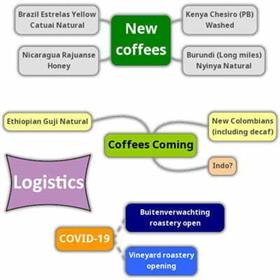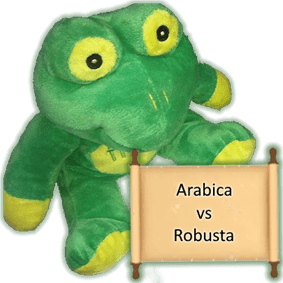Short and Sweet Summary
For those who find slogging through our newsletters a drudgery, here’s an “elevator” mind map:
In summary:
- New coffees:
- Kenyan Chesiro (PB) Washed
- Brazilian Cinco Estrelas Natural
- Burundian Long Miles Nyinya Natural
- Nicaraguan Rajuanse Honey
- Coffees coming:
-
- Ethiopian Guji Natural (to replace Limu)
- New Colombians with the new Decaf
- Possibly new Indonesians
-
- COVID-19 update:
- We are basically up and running at Buitenverwachting
- Some days at Vineyard soon
- Logistics – a long read
For those that have made it here, brew a cup before mounting the task of reading on. Ready – read on McDuff.
To start, we thought we would explain the various ways our coffees get to us. This is followed by the detail of what is bulleted above.
The Logistic Challenges of Coffee
One of the significant challenges in offering coffees we love to drink (and share) is that they are very seldom offered by local importers. On occasion, we have been able to benefit from what is available lying in warehouses all around the country. The South African coffee industry has shown quality (even what we consider necessary quality) is not their primary driver. Importers have hence learnt to offer “value” coffees (or commodity coffees), as these sell. Cost seems to be king (or queen) for most of the industry (oh dear is this one of those us and them things, we are better than them because things?, USP things?)
It all changed for us in 2008. We tasted and then imported our very first shipment of coffee, which we loved. A result was our own perception of quality coffee changed forever. Like many things in life, once you have had something that is able to change your perception of what is out there, it is often hard to go back. Since 2008 we have progressively tried to move to a minimum quality coffee offering.
While our move to a completely direct model has been hampered by pricing and availability, what follows is a basic summary of the various ways coffee gets to us, so we can get it to you.
Easy-peasy Way
Some of our coffees, we are literally able to pick up the phone and get hold of a local green importer. A day or two later, we can either fetch or expect a delivery. Working like this is easy. Limited cash flow issues, and we have to hold minimal stock. This is also how most of the coffee world works (besides the large multi-nationals). The limitation is that what is available, is available. Should we care? After all, these are single origin coffees, and someone somewhere is producing it and getting some financial reward indirectly. You can often also find organic, fairly traded and traceable coffees in these collections. Local people are hired, and money stays within the South African economy so, this is good.
So, what is the drawback?
The most important factor is taste. Since we are keen to let the coffee flavours to be exposed, rather than the roast (yes that thing, the thing we get asked more times than we are happy to admit. “Is this a medium or dark roast”). What do you mean by that? (the pompous coffee ex-spurt asks). What we mean is that some coffees, the only way to get them to taste of anything is to get them to taste of coffee or roast degree. If that is what you want cool, we won’t judge (sort of). That is why we offer Old-school and Zine. (Do a sense a glove about to be slapped against my face?)

Okay, enough of this silliness (sorry Graham). The issue is that only well cared for coffee has tasty flavour notes. Care in all steps from cultivation to processing to packaging to shipping and yes roasting of the coffee.
The “Sort of” Easy-peasy Way (Sometimes)
Sometimes (only sometimes) there is an existing importer that dabbles in bringing in a more premium offering. And sometimes we are able to work with these importers to source some lots. Sometimes (again with that word) okay every so often, we can partner with these parties to bring in coffee they, or we have identified as a tasty coffee. Such was the case for the Long Mile coffees we offered before (2014-2018). We were able to work with 2 different local partners to secure these coffees. At times (i.e. sometimes) this has worked out well. Our Yirgacheffe Kochere, which we have now offered for 4 seasons running, initially was an imported SPOT coffee (see below). Then we sourced it via the one partner and now another.
If these parties can get it right, this is a great way to work. Especially if they are transparent. Frequently (also sometimes) either we will (or they will) source a pre-crop or early crop of the coffees we are interested in. We are then able to either cup (read taste) these coffees with or without other roasters (sometimes). Then we need to make a commitment to take the coffee if it gets to South Africa. If (and this is a big sometimes) there is enough of a commitment or the importer is prepared to gamble; the coffee will be secured at origin (by the import partner). They will organise the logistics (not sometimes, most times). The importer not only pays their agent/partner at origin but also secures the logistics, forex forward insurance, clearance documentation and everything to get the coffee to their warehouse. All we have to do is be ready to take some when it gets to our (most times) sunny country. Also, typically (although sometimes not) we only have to pay for what we need when we take it. So, this is why this is a sort of easy-peasy way. Since all we need to do is taste (we always do that) and commit to the coffee (sometimes we do that) and then roast and sell what we thought we could (which sometimes we don’t).
Sometimes other roasters have committed to a great coffee, or the importer took a chance themselves and then we only get involved when the coffee gets here. This is the case for our new Brazil and Nicaraguan coffee.
SPOT Imported coffee
This method was the first method we used to source coffee (that was not Easy-peasy) in 2008. Mainly this involves identifying a partner who not only provides tasty coffee but also will offer a semi-direct method of sourcing coffee. Semi-direct means that they work as close as possible with the producer, within the limitations of the producing country.
Unlike Easy-peasy and sort of (sometimes) easy-peasy, coffee is warehoused in another country that has a direct trade route to South Africa. Either coffee is at their (or typically a central) warehouse or on its way there (afloat about to be shipped). After reading through their offering list, we request a sample. We roast the sample once it arrives, and if we like a coffee, we contact them and book that coffee. If we are fortunate enough, another local roaster that is also sourcing from this partner, so we will consolidate the coffees to ship. I say fortunate since often, this is not the case (in fact we have only been fortunate enough to do this 4 times in a decade). We will then organise the logistics to get the coffee here, process payment and various clearance documents required to get the coffee to our door or warehouse.
This option allows us to offer some great coffees. In the past a number of our “once off” coffees have been sourced this way. While it is a great way to offer a variety and different options, the one issue is that you have to take what they have or are getting. An issue is that if you are keen to offer a particular coffee again, it can be a challenge securing future seasons, and specifically the quality we want. We have tried to use this option only if we need to. Personally, I feel this is not much different from the sort-of easy-peasy model. Although payment is upfront (to reduce the forex risk and to guarantee the coffee), there is a little of a hands-off approach to the producer. Some of these coffees we have been able to secure using a more direct path, either via forward planning, direct trade or working with a local partner. This approach has become our goto when we are desperate for a particular style of coffee. One exception worth noting is when we work with forward planned coffee (see below). Sometimes we will specifically leave space on the pallets we have forward ordered to include as spot coffee or two. Our current Ecuador is an example of this.
Another example of this was our secret coffee offering we had via Yemen
Direct
While this is not often, we have done this a few times. Specifically, we have employed this method with the current Long miles coffee Nyinya. Here we work directly with a producer. The producer then will provide a pre-crop sample or a sample of what they have. Once we have tasted a coffee we like, we order it. Then we are reliant on the origin-based producer or agent to handle the milling, packing of the coffee and getting it to a point that we can secure the logistics. Ideally, a port is best. Since we are restricted by the amount of coffee we can ship, logistics will be a significant cost in securing this type of coffee. In an idealistic world, we would be able to find a way to use the SPOT or Forward planning approach to reduce this cost. We usually need to rely on airfreight (which besides its capital cost, also has an environmental cost) or need to find a way to get the coffee here that requires some innovation.
Forward planning
If we could secure all our coffee this way, we would be happy frogs. Here we work with a partner that has local feet on the ground (like Caravela) who give us some indication of the crop cycle of a particular origin. We then use our internal systems to calculate our season-to-season requirements of the coffees we want. Typically we are looking for a coffee that will be regional and flavour specific. We then provide these numbers to the partner we are working with. Before coffee is even picked, the partner knows we require a particular quality of coffee from that region. As you can imagine, this is a longer process, linked to the date of when the first coffees become ripe. If we do not get our acts together, we can often lose these coffees (which is what happened 2 years ago with ASOrganica). All roasters the partner works with, like this, put all their requirements in on time. Then once the coffee is picked and processed, each request is serviced as a first in first out request. If we submit our request late and the harvest that year has a smaller percentage of the quality we want, then we get a smaller (or no) allocation. We have learnt to accept that we can incorrectly predict the demand for a particular coffee. As a result, before we can secure the new season, the coffee is gone.
For this approach, we have tried several methods to get the coffee here. Since the trade routes to Cape Town are limited, we often consolidate shipments in other countries first, then ship the coffee here. We have waited up to 5 months from the coffee leaving origin (8 months from order) to arriving here. However, as time has gone by, we are getting better at this. Now we have got these lead times down to about 4 months from placing the season order to securing the coffee. Obviously, that excludes extenuating circumstances like COVID-19 lockdown.
Coffee News
New
We have several new coffees. Some arrived delayed, but they are here now:
- Kenyan Chesiro – although this was released a month ago, this coffee has quickly become a favourite. Besides it being tasty, it has a great natural body (you cannot hold it against us). Read more about the coffee here…
- Replacing our Brazilian Sao Paulo is The yellow Catuai from Finca Cinco Estrelas (farm 5 stars). It is once again sourced indirectly via Expocaccer, the co-operative we visited in 2016. We once again believe it a great example of a very enjoyable Brazilian. Read more here…
- Our long-awaited new coffee from Long Mile Coffee Project has landed and is now available. We were hoping to secure this coffee as a collective of roasters. Then use that to persuade a local importer to assist us with the logistics, hence reduce the cost of getting it here. Unfortunately, we had to go direct, and as a result, this coffee cost us double what it could have. We have adjusted our pricing model to make the coffee as affordable as we can. The coffee is a very clean natural. Read more about Nyinya here…
- With the popularity of our La Roca from Nicaragua, we started looking for a good central American coffee under COVID-19 restrictions. We lucked out by finding a local importer (see sometimes easy-peasy) had a great example of a Honey processed coffee from a very passionate producer based in Nicaragua. We were even able to have a Whatsapp chat with Ramiro about his coffee, and we are hoping to offer his coffees more often. You can read part of the discussion on the web page dedicated to thisRajuanse Honey Honey processed coffee.
Coming
A race to get our coffee that will be replacing Limu, and our new Colombians (including the Decaf we sold out under COVID-19) is on. It looks like the coffee from Guji has been quicker out of the blocks, and should get here first. We are very excited about this coffee. We tasted it just before lockdown and cannot wait to share this coffee that reminded us of melon in the cup.
Bye
We seldom have a so long and thanks for all the brews section, but Limu is special. We have offered a coffee from Limu almost since the beginning. While we have not ruled out Limu coming back, demand for this coffee has diminished, and we have also been struggling to source one as direct as possible. We had several samples from villages in the area, but every time we try to secure some, we have been hit with some obstacle. While we can still acquire this coffee via the SPOT process covered above, we have been able to source so many of our Ethiopians in a far more direct manner. We are replacing it with a great coffee from Guji. Its taste profile is very different, but we believe it represents the area well. And there is a strong chance of a longer-term relationship with this coffee producer.
So the one queen is dead, long live the new queen.
Some Good News
So far the rand has lost about 20% this year. This decrease is almost within the envelope, we anticipated this year. A plus was that the VAT rate was not increased. We are also looking at alternative ways to keep other costs down. We have been forced to fix some of our expenses which may have longer-term effects, and take any relief we have been offered.
COVID-19 has put significant pressure on all businesses. While we have been severely affected, the extra support by you, our customers, in purchasing coffee and spreading the word has helped. Volumes may be significantly down this year, but so far, we have been able to keep our noses above water. A significant increase in equipment sales has almost balanced the decrease in coffee sales, so far. With the Jura price increases of 23% and the other equipment manufactures following suit we have seen these sales drop too, but they are just keeping us afloat.
What this means is that we are hoping to keep coffee prices as close to their current levels as possible.




